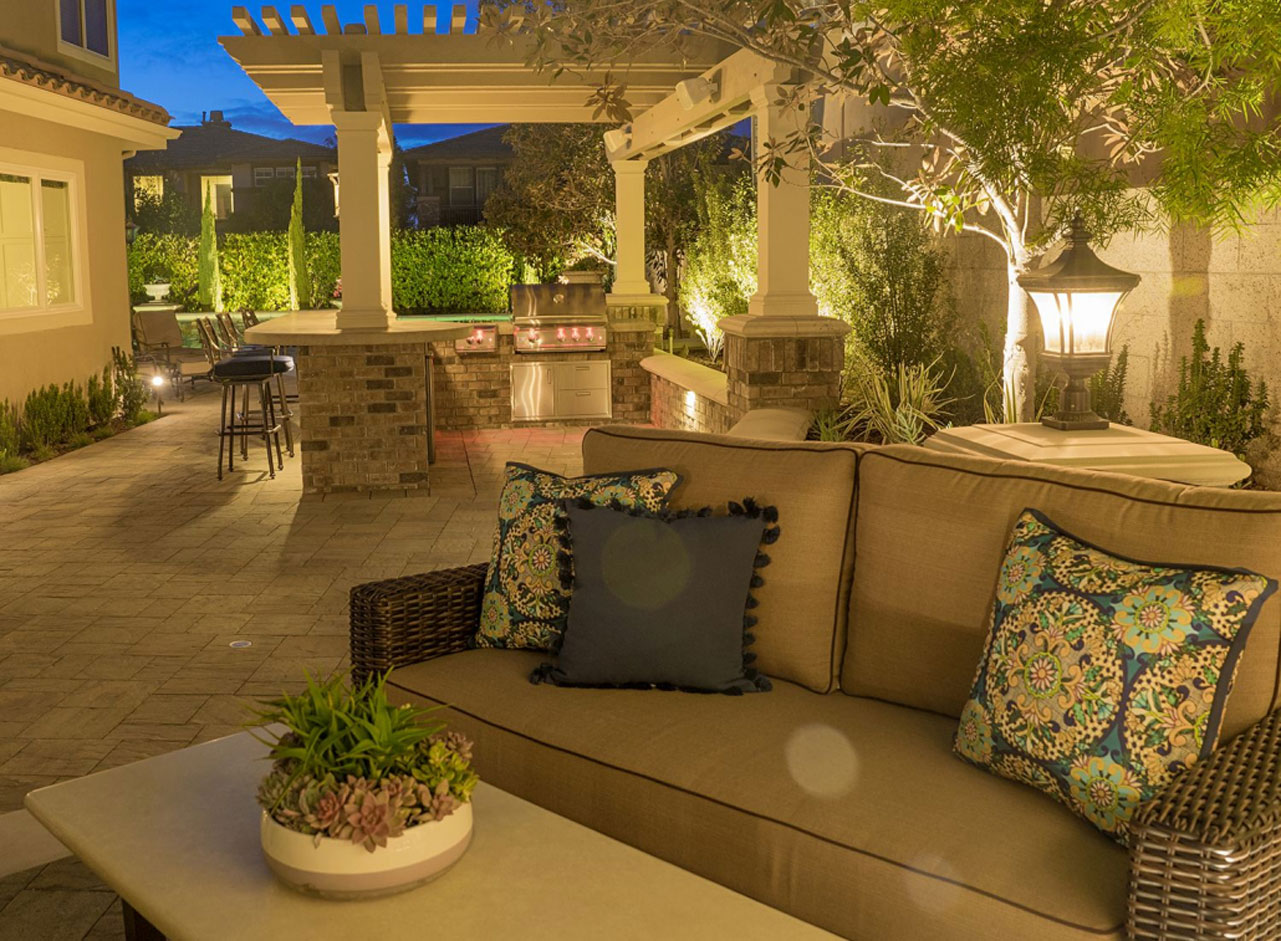
PatiosPatios are outdoor spaces adjacent to a home, typically used for dining, entertaining, or relaxation... can be a great addition to any backyard or outdoor living space, providing an area for relaxation and entertainment. However, the process of building a patio with paver installation and retaining wall blocks may seem daunting to those without experience in construction or landscaping.
Fortunately, with some basic knowledge and careful planning, creating your own beautiful and functional patio is achievable. The key to success lies in understanding the materials involved and their proper installation techniques.
Pavers and retaining wall blocks come in various sizes, shapes, colors, and textures that allow for endless design possibilities. By utilizing these elements effectively, you can create a unique space that reflects your personal taste while also enhancing your property value.
Paver installation is a popular choice for creating an elegant backyard patio. Pavers can be made of various materials, including concreteConcrete is a composite material made from a mixture of cement, sand, gravel, and water. It is one o..., natural stones, and clayClay is a natural, fine-grained soil material that becomes pliable when wet and hardens when dried o... bricks.
Concrete paversConcrete pavers are precast, man-made paving stones made from a mixture of cement, sand, gravel, and... are the most common because they are durable, easy to install, and come in different shapes and colors that can fit any design style.
Creating a backyard patio is an excellent way to enhance your outdoor space, and pavers are perfect for this purpose.
The paver installation process involves preparing the site by removing any grass or debris, levelingLeveling is the process of creating a flat, even surface in preparation for construction or landscap... the area with sandSand is a fine, granular material composed of finely divided rock and mineral particles. It is a fun... or gravelGravel consists of small, loose, rounded or angular stones, typically ranging in size from a few mil..., and laying the pavers in a pattern of your choice.
Concrete pavers are a popular choice for patios because of their durability and versatility. These square-shaped blocks come in a variety of colors, sizes, and textures, allowing homeowners to create unique designs that suit their style preferences.
Retaining walls are an essential part of any patio project that requires elevation changes.
Concrete wall blocks are one of the most popular materials for building retaining walls due to their durability and ease of installation.
Now that we have discussed the basics of retaining walls, let's move on to planning your patio design with pavers and retaining walls.
Before starting any project, it is important to consider the purpose and function of your space. Will you be using your patio for dining or entertaining? Do you need a designated area for cooking or grilling? These questions will help determine the size and layout of your patio.
The size and shape of your patio will depend on the available space in your backyard, as well as your personal preferences. When choosing a size, consider how you will use the patio - do you plan to entertain guests or simply relax with family?
As for shape, there are many options including rectangular, square, circular, or freeform. Rectangular and square shapes tend to be more formal and structured while circular and freeform shapes offer a more natural look.
The location of a patio is crucial to its overall functionality and aesthetic appeal. When choosing the perfect spot for your patio, consider factors such as accessibility, privacy, sun exposure, landscaping, and drainage.
Ideally, the patio should be easily accessible from your home's interior or exterior spaces without disrupting other outdoor activities. It should also offer some levelA level is a tool used to determine whether a surface is horizontal (level) or vertical (plumb). It ... of privacy while allowing you to enjoy scenic views of your garden or backyard.
One of the key factors in creating a visually appealing patio is selecting the right pattern and layout for your pavers.
There are several options to consider, including running bond, herringbone, basket weave, or even a unique custom design.
The choice ultimately comes down to personal preference and the overall style of your outdoor space.
After determining the layout and pattern of pavers for your patio, it is important to measure the area for groundwork preparation. This step will ensure that you have enough materials to complete the project and will also help in estimating costs.
Start by measuring the length and width of the area where you want to install your patio. Use a tape measure or laser levelA laser level is a precision tool used in landscaping and construction to ensure that surfaces and s... to get accurate measurements.
Once you have these dimensions, calculate the square footage by multiplying length times width. It is recommended to add an extra 10% to account for any cuts or waste during installation.
Before laying the base layer for your patio with pavers and retaining wall blocks, it is important to dig out the area properly. This step serves as a foundation for ensuring the stability and longevity of the project.
Start by marking off the perimeter of the desired patio space using stakes and string lines. Then use a shovelA shovel is a versatile hand tool used in landscaping and construction for digging, lifting, and mov... or an excavator to remove any grass, plants, or debris within that area.
Properly preparing the soil before laying down a gravel layer is crucial for creating a durable and stable patio with pavers and retaining wall blocks. To achieve this, it is important to compact the soil thoroughly.
After compactingCompacting is the process of compressing soil, gravel, or other base materials to eliminate air gaps... the soil, the next step in building a patio with pavers and retaining wall blocks is to add a layer of gravel for proper drainage. This helps prevent water from accumulating on the surface and causing damage over time.
To ensure better drainage and prevent water accumulation, it is recommended to lay perforated pipe in addition to the base layer of gravel. The perforated pipe will help transport any excess water away from the patio area and into a designated drainage system.
After laying the perforated pipe for further drainage assistance, it is time to move on to installing the retaining wall blocks. These blocks will serve as a barrier to hold back soil and prevent erosion while also providing stability for your patio.
To ensure a successful patio project, in this subsequent section, we will guide you through the process of preparing your wall block layout.
Calculating the amount of retaining wall blocks required for building a patio is crucial in determining the cost and ensuring that you have enough materials to finish the project.
Now that you have calculated the number of wall blocks needed for your patio project, it's time to move on to the installation process.
The first step is to prepare the area where you will be installing the retaining wall blocks. Make sure the ground is level and compacted before beginning.
Next, begin laying out the blocks in the desired pattern, ensuring they are level as well. As you lay each block, use a rubber malletA rubber mallet is a type of hammer with a rubber head, used in landscaping and construction to appl... to tap it into place and check for levelness using a bubble level.
Adding caps to the top of your retaining wall is not only functional but also adds a polished look. Caps can be made of various materials such as natural stone, concrete, or brickBrick is a building material made from clay, sand, and water, molded into rectangular blocks and fir... and come in different sizes and styles. It's important to choose a cap that matches the color scheme and aesthetic of your patio design.
Once you have selected your cap, place it on top of the wall blocks using adhesive specifically designed for outdoor use.
Filling gaps between pavers with sand will help prevent weeds from growing and provide stability for foot traffic. Use a broom to sweep sand into all joints until they are completely filled.
If you are looking to make a patio with pavers and retaining wall blocks, our team can design the perfect layout for your outdoor space.
Paver patiosPaver patios are outdoor spaces constructed using interlocking pavers, offering a durable and visual... offer an array of benefits such as durability, easy maintenance, and aesthetic appeal. Retaining walls provide both functional support and enhance the overall look of the area by adding depth and dimension.
Our team of professionals has years of experience in designing custom hardscapes that fit seamlessly into any landscape while providing functionality and beauty.
With our attention to detail and expertise in masonry work, they will ensure that your backyard patio is constructed properly using high-quality materials to withstand weather changes and heavy foot traffic.
Let us turn your backyard into a stunning outdoor living oasis that you can enjoy year-round, contact us at 714-519-5009 at West Hills Masonry today!
 Carlos Gonzales
Carlos GonzalesLocations We Serve
Schedule A Consultation